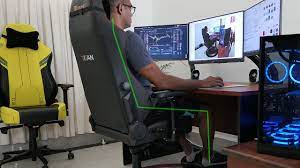As passionate gamers, we understand the allure of extended gaming sessions, but the toll it takes on posture can lead to discomfort and health issues. In this guide, we’ll delve into practical strategies and actionable tips on how to fix bad posture while pc gaming. Whether you’re a casual player or a dedicated enthusiast, mastering the art of maintaining proper posture can enhance not only your gaming experience but also contribute to a healthier and more enjoyable long-term journey in the digital realm.
How to fix bad posture while pc gaming
Begin by evaluating your gaming environment. Choose a chair that supports your back and provides proper lumbar support. Make sure your desk is at an appropriate height to avoid hunching over, and position your monitor at eye level to reduce strain on your neck, there are some steps that you must follow, which are as follows:
Step 1: Ergonomics Matter
Invest in an ergonomic gaming chair that promotes a neutral spine position. This doesn’t have to break the bank—there are affordable options designed to provide comfort during those marathon gaming sessions. Adjust the chair height to keep your feet flat on the ground and your knees at a 90-degree angle.
Best Budget Gaming Monitor for Xbox Series S
Step 2: Perfect Your Gaming Station Setup
Arrange your gaming peripherals strategically. Your keyboard and mouse should be within easy reach to prevent unnecessary reaching or leaning. This not only enhances your gaming performance but also supports better posture.
Step 3: Mindful Gaming Sessions
During your gaming sessions, take short breaks to stand up, stretch, and walk around. It’s easy to get absorbed in the virtual world, but these breaks are essential to prevent stiffness and maintain good circulation.
Step 4: Stretch and Strengthen
Incorporate simple stretching exercises into your routine to counteract the effects of prolonged sitting. Focus on your neck, shoulders, and lower back. Strengthen your core muscles with exercises like planks and bridges to provide additional support for your spine.
Step 5: Posture Check-In
Develop a habit of checking your posture regularly. Ensure your back is straight, shoulders relaxed, and head in a neutral position. It may feel odd initially, but with practice, maintaining good posture becomes second nature.
Step 6: Tech Tools for Support
Explore posture-correcting apps or devices that provide gentle reminders to sit up straight. These can be subtle yet effective aids in building long-term posture habits.
By incorporating these steps into your gaming routine, you’re not just fixing bad posture; you’re ensuring that each gaming session contributes to your overall well-being. Remember, it’s about finding the right balance between an immersive gaming experience and maintaining a healthy posture for the long run.
Understanding the Impact of Bad Posture

Begin by recognizing the significance of posture on your overall well-being. Understand that prolonged periods of bad posture can lead to discomfort, muscle imbalances, and potential long-term health issues. This awareness is the first step towards positive change:
Step 1: Recognize the Signs
Educate yourself about the signs of bad posture. Be mindful of common symptoms such as back pain, neck strain, and headaches. This recognition allows you to take proactive steps before these issues escalate.
Best budget gaming monitor for ps4 this year!
Step 2: Grasp the Long-Term Consequences
Dig deeper into the potential long-term consequences of maintaining poor posture. Learn about how it can affect your spinal health, muscle integrity, and even respiratory function. This knowledge serves as a compelling motivator for making positive changes.
Step 3: Connect with Personal Goals
Relate the impact of bad posture to your personal goals. Whether it’s enjoying pain-free gaming sessions, being more productive, or simply feeling better, understanding how posture aligns with your aspirations adds a personal touch to the process.
Step 4: Empathy for Future Self
Develop empathy for your future self. Envision the potential discomfort and health challenges that may arise if bad posture habits persist. This forward-looking perspective can be a powerful motivator for taking proactive steps today.
Understanding the impact of bad posture is not just about recognizing the physical repercussions; it’s about connecting with your own body, acknowledging personal goals, and envisioning a healthier future. By taking these steps, you’re not just addressing bad posture—you’re actively investing in your well-being.
Assess Your Gaming Environment
Begin by evaluating your current gaming setup. Take note of your chair, desk, and monitor arrangement. Ensure that your gaming space promotes comfort and allows for proper posture. This initial assessment sets the stage for creating an ergonomic haven.
Invest in an Ergonomic Gaming Chair
Consider investing in an ergonomic gaming chair that supports the natural curve of your spine. Look for adjustable features, such as lumbar support and armrests. Your chair should allow you to sit comfortably for extended periods without sacrificing proper posture.
Best budget gaming monitor for laptop
Optimize Desk Height and Monitor Position
Ensure that your desk is at an appropriate height to prevent hunching over. Position your monitor at eye level to reduce strain on your neck. This simple adjustment promotes a more neutral and comfortable gaming posture.
Choose the Right Peripherals
Select gaming peripherals that contribute to ergonomic comfort. Your keyboard and mouse should be positioned within easy reach to prevent unnecessary stretching or straining. Consider peripherals designed with ergonomic features for added support.
Customize for Your Comfort
Don’t hesitate to customize your gaming setup based on your unique preferences and body proportions. Small adjustments, such as the angle of your monitor or the height of your chair, can make a significant difference in maintaining good posture.
By following these practical steps to create an ergonomic gaming setup, you’re not just enhancing your gaming environment; you’re investing in your own well-being. Remember, the goal is to make your gaming sessions not only thrilling but also physically supportive for the long run.
Gaming Posture Dos and Don’ts
Start by positioning yourself at the back of your chair, allowing your back to rest comfortably against the chair’s backrest. This helps maintain the natural curve of your spine and prevents unnecessary strain on your lower back:
Keep Your Feet Flat on the Floor
Ensure your feet are planted flat on the floor. This provides a stable base and helps distribute your weight evenly. If your feet dangle, consider using a footrest to support proper posture.
Maintain Neutral Spine Alignment
Keep your spine in a neutral position, avoiding excessive slouching or arching. Imagine a straight line from your head to your lower back. This alignment minimizes stress on your spine and contributes to a healthier posture.
Take Regular Breaks and Stretch
Incorporate short breaks into your gaming sessions. Stand up, stretch, and move around to prevent stiffness. Simple stretches for your neck, shoulders, and back can refresh your muscles and promote better circulation.
Don’ts
Avoid Slouching or Leaning Forward
Steer clear of the temptation to slouch or lean forward excessively. These positions can strain your back and neck muscles, leading to discomfort and potential long-term issues. Remind yourself to stay mindful of your posture during intense gaming moments.
Say No to Prolonged Static Positions
Avoid staying in one position for too long. Prolonged static positions can contribute to muscle fatigue and stiffness. Make it a habit to shift and readjust your posture regularly, especially during extended gaming sessions.
Don’t Ignore Discomfort Signals
Listen to your body. If you start feeling discomfort or pain, take it as a signal to reassess your posture. Ignoring these signals can lead to more significant issues down the road. Address any discomfort promptly and make the necessary adjustments.
By incorporating these dos and don’ts into your gaming posture habits, you’re not just playing a game; you’re actively safeguarding your physical well-being for the long run. Remember, it’s the small adjustments that lead to significant improvements over time.
Technology Tools for Posture Improvement
Start by exploring available posture correction apps that can serve as gentle reminders during your gaming sessions. These apps often provide notifications to encourage you to sit up straight and take breaks. Choose one that integrates seamlessly with your gaming routine.
Consider Posture-Supportive Gaming Accessories
Look into gaming accessories designed to support good posture. This could include lumbar support cushions, ergonomic mousepads, or chairs with built-in posture-friendly features. Select accessories that align with your specific comfort needs and gaming setup.
Try Wearable Posture Devices
Explore wearable devices designed to monitor and improve your posture. These can range from discreet posture trackers to smart shirts that provide real-time feedback on your body alignment. Find a device that complements your gaming lifestyle without causing distraction.
Conclusion
In conclusion, mastering the art of maintaining good posture while PC gaming is not just a practical necessity—it’s an investment in your long-term well-being and the overall enjoyment of your gaming experiences. By following the steps outlined in this guide, from creating an ergonomic gaming setup to adopting posture-friendly habits, you’re not only addressing the immediate discomfort associated with bad posture but also proactively preventing potential health issues down the road.

